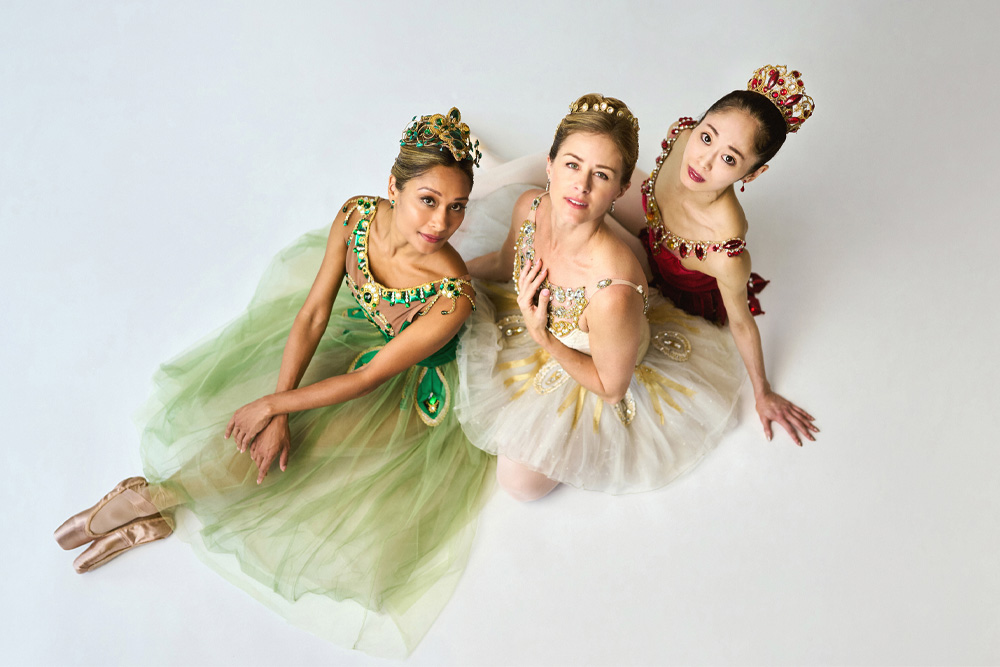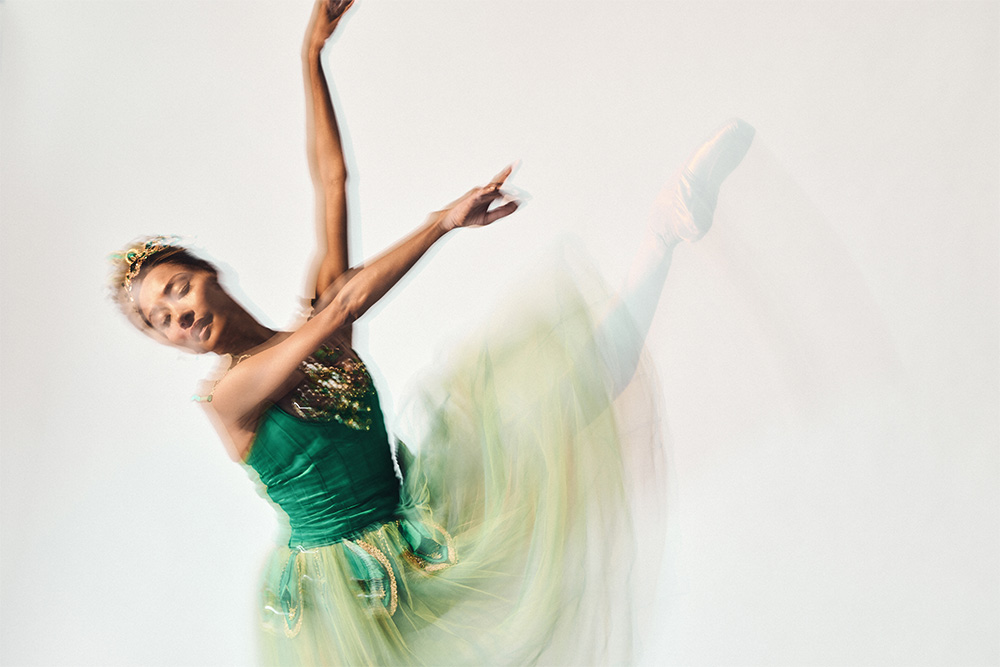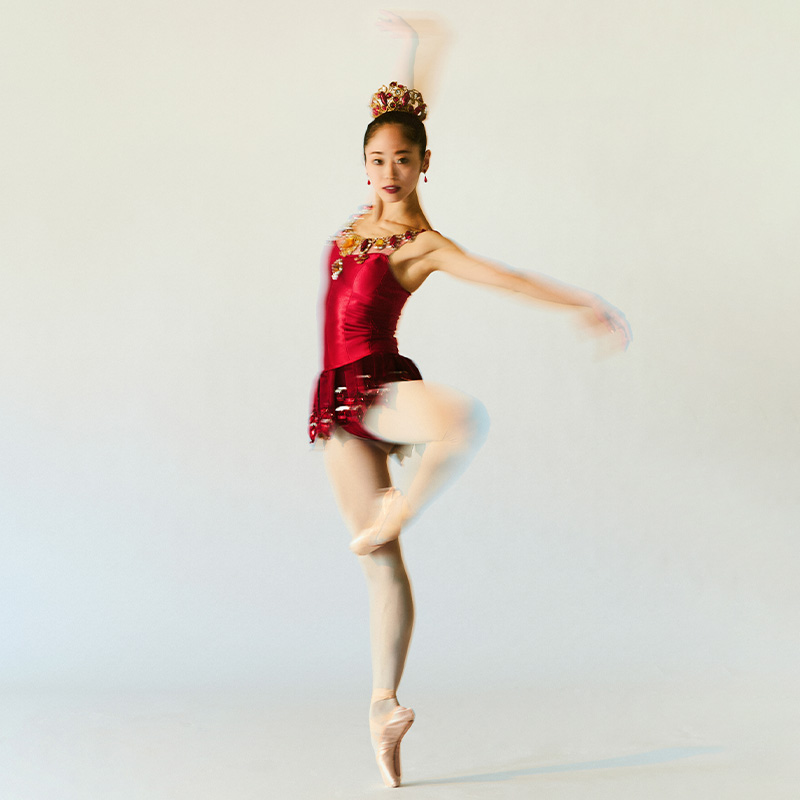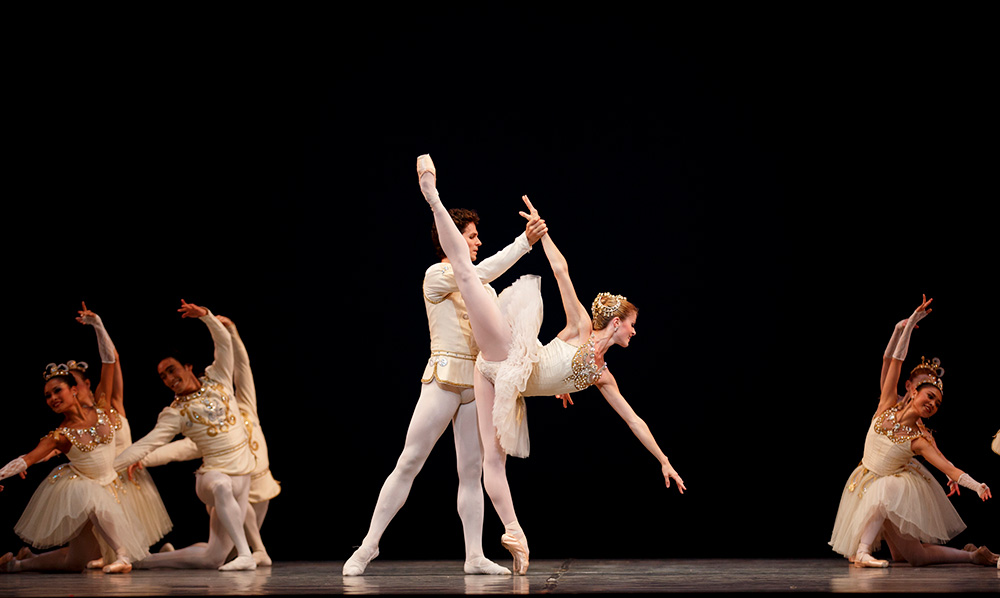A Closer Look at Jewels
by Caroline Dickie
May 1, 2024

- Tina Pereira, Heather Ogden and Koto Ishihara. Photo by Karolina Kuras.
The athleticism and musicality of Jewels are so exquisite you don’t need any prior knowledge to get the most from this iconic ballet. In fact, George Balanchine traded conventional storytelling for pure movement in a way that creates space for dancers and audiences to bring their own ideas to his work. But a closer look at Jewels tells its own story about why this ballet is so integral to the Balanchine canon and an enduring favourite worldwide. Read on to add extra colour and clarity to your Jewels experience!
There’s no plot…
Jewels is a full-length abstract ballet in three acts, the first of its kind in the world! Balanchine created it in 1967 as a star vehicle for his top dancers at New York City Ballet, the company he co-founded with Lincoln Kirstein in 1948. While there are no characters in Jewels, the ballet has an incredible nine principal roles. Balanchine tailored each one to his chosen dancer, from Violette Verdy’s ethereal role in Emeralds to Patricia McBride’s sassy turn in Rubies and Suzanne Farrell’s refinement in Diamonds with Jacques d’Amboise. Jewels was also Balanchine’s chance to celebrate the company’s new home at Lincoln Center with a showy, “we’ve arrived”!

Tina Pereira. Photo by Karolina Kuras.
…but there is a theme
Each of the three acts in Jewels evokes the colour and character of a precious stone: Emeralds, Rubies and Diamonds. Balanchine was inspired by the gorgeous window displays at Van Cleef & Arpels on Fifth Avenue, a New York City institution and potential corporate sponsor. It’s also true that Balanchine simply admired the qualities of jewels, saying “I like the colour of gems, the beauty of stones.”
You can see the music
Balanchine is one of ballet’s most musical choreographers and he believed dance should be visual music. His famous motto, “see the music, hear the dance,” goes a long way toward explaining his achievement in Jewels, where each act visualizes the music of a different composer: Fauré for Emeralds, Stravinsky for Rubies and Tchaikovsky for Diamonds.

- Koto Ishihara. Karolina Kuras.
It's urban
Cities may not be the first thing that springs to mind on watching Jewels, however each act is devoted to an urban centre and corresponding choreographic style that played a role in Balanchine’s life. Emeralds evokes the French Romanticism of the Paris school, Rubies the jazzy modernity of New York City and Diamonds the formal classicism of the Imperial Ballet in Saint Petersburg, where Balanchine trained. The Lincoln Center Festival marked the 50th anniversary of Jewels with three representative companies performing each act: Paris Opera Ballet for Emeralds, New York City Ballet for Rubies and Bolshoi Ballet for Diamonds. What a celebration!
It's fashion
It would be an oversight to look closely at Jewels without mention of its stunning costumes – the effervescent green tutus of Emeralds, the chic red tunics of Rubies and the gilded white bodices of Diamonds. They were designed by Balanchine’s most trusted costumer and theatre legend, Barbara Karinska, who among other things won an Oscar for Best Costume Design in 1949 for Joan of Arc, starring Ingrid Bergman. Balanchine once said, “There is Shakespeare for literature, Karinska for costumes.”

Guillaume Côté and Heather Ogden with Artists of the Ballet in Diamonds from Jewels. Photo by Bruce Zinger.
Dancers love it
You would be hard-pressed to find a dancer who doesn’t love Jewels. The three acts offer unique styles of movement, multiple opportunities for solo and principal work as well as grand ensembles. The reward of Balanchine’s choreography lays in its challenge, a perfect recipe for ambitious dancers. Principal Dancer Heather Ogden describes it this way: “With Balanchine we get to use our instrument to the fullest. He was known to expand the vocabulary and limits of a dancer’s body and it is always a challenge and pleasure to push ourselves to new limits. Balanchine’s understanding of and reverence for the music is like no other choreographer and that makes dancing his work feel completely harmonious, organic and fulfilling. I couldn’t be more excited for Jewels. It is not to be missed!”
Don’t miss George Balanchine's Jewels on stage June 15 – 22, 2024! Learn more